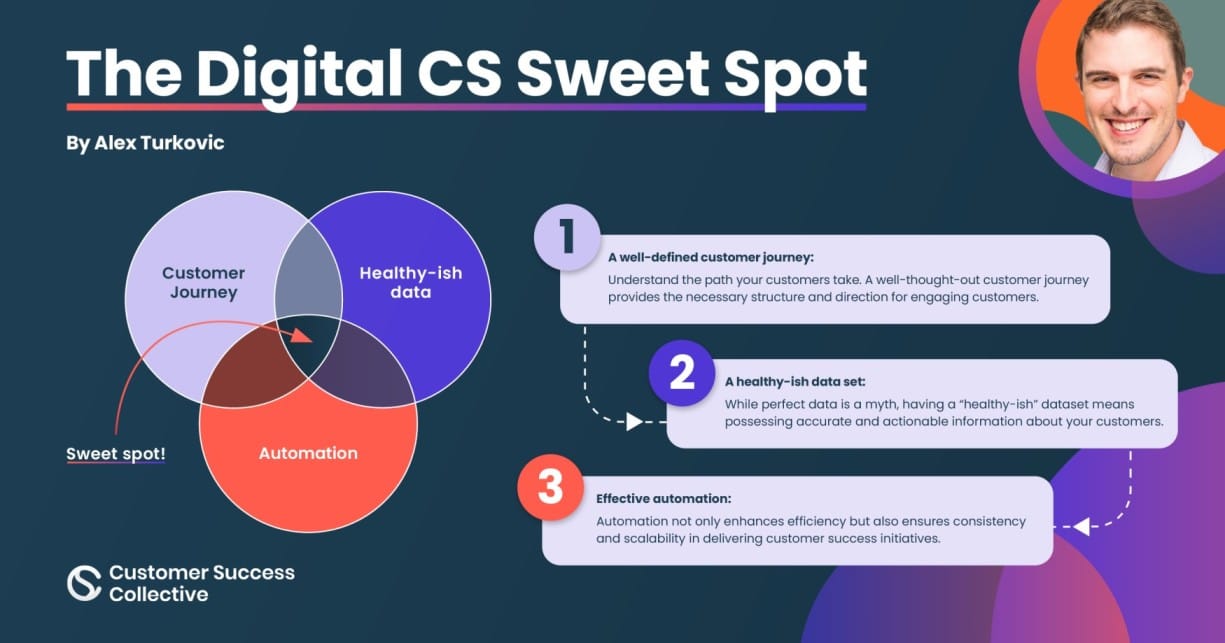This article is based on an episode of the CS School podcast with Alex Turkovic.
Digital customer success is about much more than implementing tools; it's about crafting meaningful, timely interactions that guide customers effectively through their journey with your product or service.
For the last three years, I’ve been leading Digital Customer Success and Customer Education at Snow Software. My path has been about exploring and defining the evolving landscape of customer engagement. Through my experiences and dialogues on my Digital Customer Success Podcast, I've aimed to demystify the complexities of digital customer success, making it accessible and strategically integral to achieving our broader business goals.
This article is a deep dive into understanding digital customer success as a nuanced, comprehensive strategy that enhances customer relationships and drives success across the board.
Specifically, we’re going to cover:
- How to integrate digital strategies with broader customer success
- The trick of balancing both human and technological elements
- The pivotal role of generative AI
- Adopting digital tools to streamline processes
- Delivering high-touch service at scale
- Identifying the “digital customer success sweet spot”
Alex explained how you can leverage the power of AI, automation, and human touch to create a perfect symphony that enhances customer experiences.
What's not to love?
Integrating digital strategies with broader customer success
The perception of CS as an overly complex field is something I've encountered frequently. It's often seen as a black box – a solution that, once implemented, miraculously resolves all challenges within the customer journey. This view simplifies and somewhat misrepresents the nuanced and strategic nature of digital CS.
At its core, digital customer success is about timely and persona-specific engagement with customers. It's a strategic approach aimed at guiding customers through their journey to achieve desired outcomes.
This involves not just direct interactions, such as one-to-one relationships managed by Customer Success Managers (CSMs), but also scalable digital interventions like email campaigns and in-app guidance. These tools and strategies are integral to fostering customer success.
In my work at Snow Software, and through conversations on my podcast, I've emphasized the importance of understanding digital CS as a multifaceted strategy rather than a one-size-fits-all solution. It's about creating internal efficiencies and making CSMs more effective in their roles. Whether through digital touchpoints or operational tactics, every action taken is part of a broader strategy aimed at supporting customers' success.
Furthermore, the distinction between digital CS and CS operations is often blurred. Many tasks traditionally associated with CS operations, such as campaign management or quarterly business review (QBR) templates, can also fall under the “digital CS umbrella.”
This overlap showcases the inherent integration of digital strategies within the broader customer success framework, highlighting the need for a simplified, strategic approach to digital customer engagement.

Balancing the human and digital elements
The balance between the human aspect and the utilization of digital tools in customer success is a nuanced and often debated topic. It's a misconception to view the relationship between human empathy and digital efficiency as an either-or scenario.
In reality, the most effective customer success strategies seamlessly integrate both elements, ensuring that customers receive personalized, empathetic support while also benefiting from the efficiency and scalability that digital tools provide.
In my perspective, every digital strategy should inherently include a human touchpoint, and conversely, every human-driven customer success initiative should leverage digital tools to enhance efficiency and reach. This approach allows us to guide customers through their journey as directly and effectively as possible. For instance, consider the post-survey engagement strategy.
While a survey's automated responses and splash pages represent a purely digital tactic, the act of personally responding to customer feedback – whether through email or a phone call - adds a critical human element. This response acknowledges the customer's input and reinforces the value of their feedback, whether it be positive or negative.
Such strategies exemplify the synergy between digital and human efforts in customer success. By automating routine tasks, we can free up CSMs to focus on high-value interactions that require a personal touch. This not only enhances the customer experience but also optimizes the effectiveness of the CSM by allowing them to concentrate on areas where they can make the most significant impact.
This dual approach is key to developing successful digital customer success strategies, where digital tools and human insight work hand in hand to support and advance customer goals.

The pivotal role of technology in advancing customer success
The integration of technology into customer success has been a significant topic of discussion and development in recent years. The landscape of customer success has transformed dramatically, with technological advancements playing a pivotal role in shaping new strategies and capabilities.
Leveraging generative AI to enhance (not replace) human insights
Generative AI, while a hot topic that can sometimes generate skepticism due to fears of job displacement, is not about replacing human interaction but enhancing it.
The current and potential applications of generative AI in customer success are vast, ranging from generating meeting and account summaries to providing insights into customer engagements. These tools, such as those offered by platforms like Gainsight and Update AI, represent just the beginning of how generative AI can support the customer success domain.
The perception among CSMs that AI might replace their roles is understandable but not entirely accurate. Instead, generative AI should be seen as a tool for deflection and enhancement. It has the potential to handle repetitive inquiries and tasks, allowing CSMs to focus on more complex, value-added interactions.
By automating routine communications and analyses, generative AI can provide CSMs with comprehensive insights into customer behavior, preferences, and challenges. This enables CSMs to engage in more meaningful conversations, armed with a deeper understanding of the customer's journey and needs.
Automation in customer success
Looking forward, the true power of generative AI in customer success lies in its ability to augment human capabilities. By taking over tasks that consume significant time but add little strategic value, AI allows CSMs to concentrate on building stronger, more personalized relationships with customers.
This shift not only increases the efficiency and effectiveness of customer success teams but also enhances the overall customer experience by ensuring that engagements are more relevant, timely, and impactful.
The evolution of customer success is intricately linked to technological advancements. Generative AI represents a key component of this evolution, offering tools that streamline operations and empower CSMs to deliver exceptional customer experiences.
As the field continues to evolve, the integration of human insights and digital tools will remain central to developing successful customer success strategies.

Adopting digital tools to streamline workflows
The integration of digital tools plays a critical role in enhancing the effectiveness and efficiency of CSMs. For individuals and teams, especially in smaller organizations, understanding how to incorporate these digital resources into daily workflows is essential for driving better outcomes and fostering customer relationships.
The idea that digital operations require a separate dedicated team is a misconception. Instead, the focus should be on how CSMs can utilize digital tools and strategies to streamline their processes and improve customer engagement.
For instance, the simple act of creating and using email templates is a form of digital enablement. Sharing these resources and best practices within the team can significantly boost overall efficiency and effectiveness.
Fostering cross-functional collaboration
One of the key strategies for CSMs, particularly in smaller teams, is to foster cross-functional collaboration.
Partnering with marketing and product teams can unlock additional communication channels and tools that may not be directly accessible within the customer success function. Marketing teams, for example, often have sophisticated email automation tools and strategies that can be leveraged to support customer success initiatives.
This collaboration extends beyond just sharing tools; it's about aligning messaging, goals, and customer insights to ensure a cohesive and comprehensive approach to customer engagement. By utilizing available resources, such as free digital tools and platforms, CSMs can overcome potential limitations and enhance their ability to support customers effectively.
For CSMs aiming to integrate digital tools into their workflow, the focus should be on identifying repetitive tasks that can be automated, exploring available resources within and outside the organization, and collaborating across functions to maximize the impact of digital engagement strategies.
Embracing a mindset of adaptability and resourcefulness is key to leveraging digital tools for customer success, ensuring that teams can provide high-value, personalized support without being hindered by the size or structure of their organization.

Delivering high-touch service at scale through digital tools
The evolution of customer success as a field has increasingly blurred the lines between traditional segmentation approaches and the application of digital strategies.
Traditionally, the industry leaned towards assigning specific strategies based on customer segments, particularly distinguishing between high-touch, white-glove service for high-value clients and more automated, tech-touch services for lower-value customers. However, this perspective has shifted significantly in recent years.
The notion that "digital is not a segment but a strategy" underscores a transformative approach to customer success. This approach does not negate the importance of segmentation but emphasizes the integration of digital tools across all customer interactions, regardless of the customer's value or the presence of a CSM.
For example, consider the strategy around email communications. For accounts without a dedicated CSM, emails regarding product updates or other information might be sent automatically to relevant contacts within the customer's organization. In contrast, for accounts with a CSM, the strategy can be tailored.
Emails can either be sent directly from the CSM, adding a personalized touch, or the CSM can modify a template based on their understanding of the customer's needs and context before sending it. This method enhances personalization while maintaining efficiency through digital processes.
This approach to digital strategy effectively enables "high touch at scale," ensuring that even traditionally underserved segments receive attention and support previously reserved for higher-value clients.
Furthermore, by automating certain aspects of the customer engagement process, CSMs can focus on more personalized, high-value interactions. Digital tools, therefore, do not just serve to extend the reach of customer success efforts but also to enhance the quality of engagement across all customer segments.
To implement this strategy effectively, it's crucial for teams, especially those new to this approach, to consider how digital tools can complement and augment their existing workflows. The goal is to identify opportunities where automation can handle routine communications and processes, thereby allowing CSMs to devote more time and resources to personalized engagement.
This balanced approach not only increases the efficiency of customer success teams but also elevates the customer experience by ensuring that all interactions, whether automated or personal, are relevant and valuable.

Identifying the digital customer success sweet spot
The concept of the “digital customer success sweet spot” stems from the recognition that digital CS is a complex function characterized by a high degree of variability. This complexity is due to the multitude of variables involved, such as diverse data sources, tools, customer profiles, products, and both internal and external audiences.
Given this complexity, it's challenging to adopt a one-size-fits-all approach for digital CS programs across different organizations.
To address this challenge, I've identified a foundational framework that constitutes the sweet spot for a digital CS program, which can be visualized as a Venn diagram comprising three critical elements:
- A well-defined customer journey: Understanding the path your customers take with your product or service is crucial. A well-thought-out customer journey provides the necessary structure and direction for engaging customers at key moments, ensuring that digital interventions are both timely and relevant.
- A "healthy-ish" data set: The quality of your data is pivotal. While perfect data is a myth, having a "healthy-ish" dataset means possessing accurate and actionable information about your customers and their interactions with your business. This includes knowing who your customers are, identifying key personas, and having contextual data that informs your engagement strategies.
- Effective automation: The third essential component is the ability to automate processes and communications effectively. Automation not only enhances efficiency but also ensures consistency and scalability in delivering customer success initiatives.

The intersection of these three elements forms the sweet spot for digital CS, providing a solid foundation on which to build and scale digital customer success initiatives.
By focusing on a well-defined customer journey, maintaining a healthy-ish data set, and leveraging automation, organizations can create a digital CS program that is adaptable, scalable, and capable of delivering personalized customer experiences. This approach ensures that regardless of the inherent variability in digital CS, the core objectives of enhancing customer satisfaction and driving successful outcomes can be consistently achieved.




